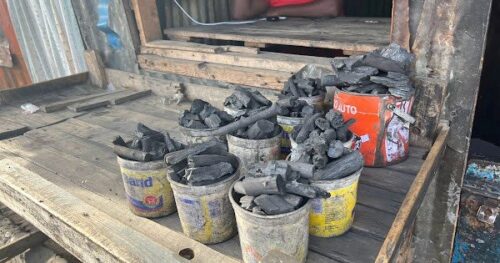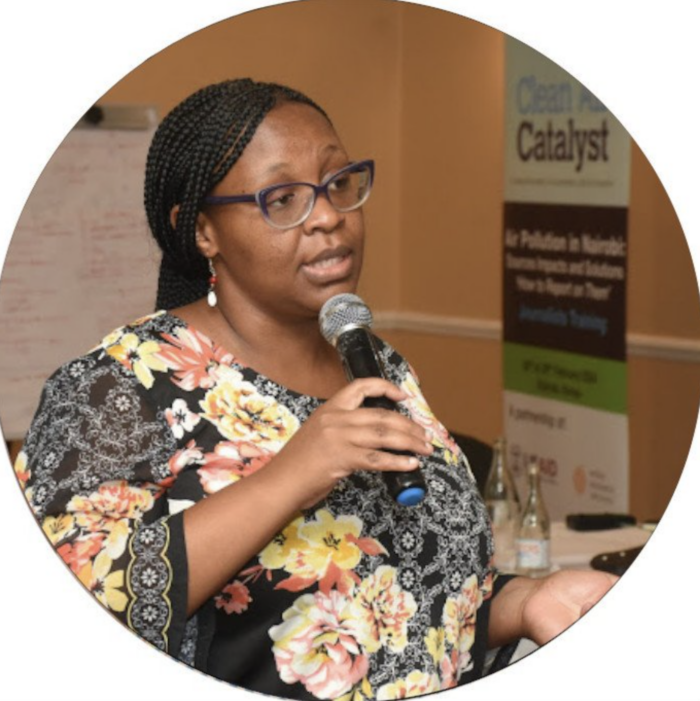Charting the Course for Gender-Responsive Clean Air Action in Nairobi

Loise—a pseudonym to protect her privacy—is a single mother of two who works at an eatery next to a major bus station in Nairobi City. Her customers are travelers coming into Nairobi early in the morning and leaving the city late at night. She arrives at the eatery by 5:00 a.m. most days and works until 8:00 p.m.
For Loise, who lives in one of Nairobi’s informal settlements, exposure to air pollution is part of her everyday life. Leaving home early in the morning exposes her to air pollution from the fumes of solid fuel burning in households and industrial waste burning from nearby factories and open dumpsites. At work, Loise prepares meals using firewood or charcoal, breathing more harmful particulate pollution into her lungs, which then travels into her blood – putting her at increased risk for heart attack, stroke, cancer, and other diseases.
Location also plays a role in her exposure to air pollution: working near a major bus station exposes Loise to emissions from vehicles whose drivers do not switch off their engines while parked. She understands the threat of air pollution and is concerned that prolonged exposure to vehicle emissions in her place of work affects her health, and indirectly, her ability to work and earn an income.
When asked if she suffers from any respiratory diseases, Loise responds that she has constant chest pains, which she treats with over-the-counter drugs. According to Clean Air Catalyst (Catalyst)’s Data Analyst William Apondo, a recent field survey of 364 eateries indicated that 65% of the employees were female while 34% were male – pointing to disproportionate negative health impacts from air pollution on women in the eateries sector.

“We asked the research participants about individuals in their household suffering from respiratory ailments. We got 274 ‘Yes’ responses, 152 of which were female, corresponding to about 55%.”
William Apondo, Data Analyst – Air Quality
Understanding the Gendered Impacts Of Air Pollution In Nairobi
Loise’s experience is one of many captured through a two-year scientific emissions inventory study conducted for the Catalyst by World Resources Institute (WRI) Africa experts, researchers from Jomo Kenyatta University and the University of Nairobi, in collaboration with the Nairobi City County Government. An emissions study is an important tool for estimating the amount and kind of air pollutants released in a geographical area over a set period of time that can be used to estimate pollutant concentrations and exposures. In the initial phase of the Catalyst study, started in January 2023 and completed over a period of 13 months, the science team conducted a field survey to collect firsthand information on the type and amount of activities producing air pollutants related to transportation, industry, household energy, commercial eateries, and waste burning. Many emissions inventories skip this step and use census or published data from national or global sources to estimate the amount of emissions from these sectors. The Catalyst’s ‘bottom-up’ approach generates more accurate, reliable data about air pollution sources.
Another unique feature is that the field research was also designed to capture the gender-differentiated impacts of air pollution, particularly in the most polluted communities. Therefore, the surveys included questions on socioeconomic status, neighborhood, gender, health conditions, and age of people living and working near emissions activities. Creating rapport with the communities proved to be a key element of the research, ensuring the survey team received honest answers, and allowing them to identify new lines of inquiry. Some of the topics that emerged included the disproportionate impact of hospital waste burning on residential areas where women and children were predominantly home during the day, and increased exposure of women to roadside emissions due to their role as small-scale traders and street vendors.
Researchers received safeguarding and gender sensitivity training to prevent and address sexual exploitation, abuse, or harassment of research participants, community members, and staff. This was part of a critical process to ensure that research protocols were in place to ensure a safe, secure, inclusive and protective environment and that reporting mechanisms existed in case of a concern or complaint. The Catalyst team further organized debriefing sessions for the research team, which gave the team an opportunity to share and deliberate on challenges experienced during the research process as a means of providing psychosocial support.
In the second phase of the emissions inventory study, Catalyst researchers are using the collected data to establish an estimated baseline inventory of emissions from key sectors for black carbon, particulate matter (PM2.5 and PM10), carbon monoxide, nitrogen oxides, and sulfur oxides, all of which are pollutants known to exacerbate health risks. This information will allow researchers to better understand the impact of air quality on Nairobi’s communities and inform decisions about which sources should be prioritized by the government to create the most meaningful, gender-smart, clean air solutions to climate and public health challenges.

“Women and girls make up half of the world’s population, however, their voices and experiences tend to be underestimated and overlooked. For sustainable clean air actions, women need to be included from the planning to the implementation phase of these actions.”
Purity Munyambu, Gender, and Equity Specialist
Additionally, the Catalyst team is using data from the emissions inventory field survey, combined with secondary data from a comprehensive literature review, to develop a gender analysis. The aim is to understand beliefs and perceptions about gender and air pollution issues in Nairobi; provide clarity regarding existing institutions, laws, and policies that address air pollution; identify gender-related gaps in air pollution policies; and provide recommendations that will inform gender-responsive air quality solutions.
Incorporating Gender and Equity in Air Pollution Solutions

“As the Catalyst Nairobi team, we have come to appreciate the need for gender mainstreaming in all our processes. This has facilitated approaches to air quality management that seek to achieve gender equity and equality while mitigating the health impacts of air pollution.”
Ivy Murgor, Program Manager – Air Quality
As the project moves forward, gender mainstreaming continues to be a key component and has shifted to include the introduction of gender-conscious thinking and procedures into the identification and design of air pollution solutions. For instance, the Catalyst is partnering with GROOTS Kenya, a women-led community-based movement, to educate members about the sources and impacts of air pollution in every aspect of their lives. According to GROOTS Kenya’s Community Health Promoter, Isabella Nzioki, the organizers have “started having conversations with women who are small-scale traders next to the road… and are noting with concern the number of women who are suffering from respiratory diseases as well as reproductive health complications due to vehicular emissions.”
By including the perspectives of citizens like Loise and members from GROOTS Kenya, the Catalyst team in Nairobi is ensuring its next steps are informed by real data and the lived experience of those most affected by air pollution. The emissions inventory process started by the Catalyst team is the initial step towards building lasting city-wide strategies to reduce the effect of air pollution on women and all people in Nairobi. It is also a step towards engaging women in gender-responsive solutions to air pollution and building agency among them to become catalysts for clean air.
This blog was originally posted on the Clean Air Catalyst website.

